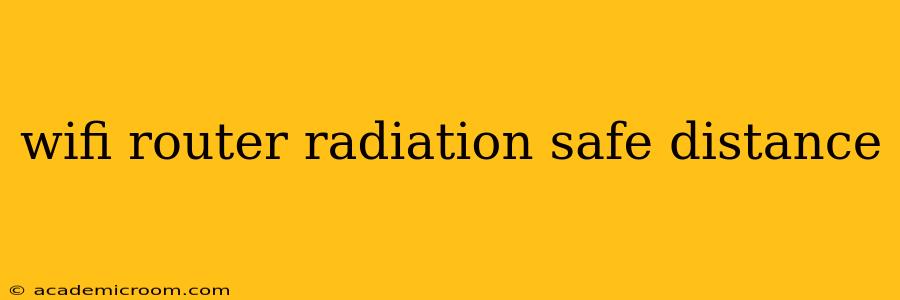WiFi Router Radiation: Safe Distance and Minimizing Exposure
The question of WiFi router radiation safety and the ideal safe distance is a common concern. While the levels of radiation emitted by WiFi routers are generally considered low and well below levels deemed harmful by most health organizations, understanding how to minimize exposure can provide peace of mind. This article will address this concern, explore the science behind it, and provide practical steps to reduce potential exposure.
What is the safe distance from a WiFi router?
There isn't a single universally agreed-upon "safe distance" from a WiFi router. The amount of radiation you're exposed to depends on several factors: the router's power output, the frequency it operates on (2.4 GHz or 5 GHz), the distance from the router, and any obstacles between you and the router (walls, furniture, etc.). The radiation emitted decreases significantly with distance. However, the levels of radiation at typical distances (e.g., a few feet away) are generally considered very low.
Many experts and health organizations, like the World Health Organization (WHO), state that current scientific evidence does not support a causal link between exposure to radiofrequency electromagnetic fields (like those from WiFi routers) and adverse health effects.
How far away should I keep my WiFi router from my bed?
The closer your WiFi router is to your bed, the higher your exposure will be, though still generally within safe limits according to current research. If you are concerned, placing your router several feet away from your bed can further reduce your exposure. Consider putting it in another room or on a different floor if feasible. Remember that walls and other solid objects will attenuate (reduce) the signal strength, thus lowering the radiation level.
Does WiFi radiation cause cancer?
The link between WiFi radiation and cancer is a subject of ongoing research and debate. Major health organizations, including the WHO, have extensively reviewed the scientific evidence and currently conclude that there is no convincing evidence to suggest a causal relationship between exposure to radiofrequency electromagnetic fields from devices like WiFi routers and an increased risk of cancer. However, research is ongoing, and it's important to remain informed about any new developments.
What are the health effects of WiFi radiation?
While the scientific consensus points to no significant health effects from the low levels of radiation emitted by WiFi routers, some individuals report experiencing symptoms like headaches or sleep disturbances. These reports are often anecdotal and haven't been conclusively linked to WiFi radiation. It's important to note that these symptoms could have other causes. If you experience such symptoms and suspect they may be related to your WiFi router, consulting a healthcare professional is recommended.
How can I reduce WiFi radiation exposure?
Even though the levels are generally low, you can take several steps to reduce your exposure to WiFi radiation:
- Distance: Keep your router a reasonable distance away from where you spend the most time, especially while sleeping.
- Placement: Position your router away from high-traffic areas and consider placing it behind furniture or walls to reduce signal strength.
- Turn it off at night: If you're particularly concerned, you can switch your router off at night when it's not actively needed. Consider using a smart plug for easy on/off control.
- Use wired connections: Whenever possible, connect devices directly to your router using ethernet cables instead of relying on WiFi. This eliminates wireless transmission entirely for those devices.
Conclusion:
While the scientific consensus suggests that the radiation levels from WiFi routers are not harmful, understanding the factors influencing radiation levels and taking simple precautions to minimize exposure can provide reassurance. Remember to consult with healthcare professionals if you have health concerns related to WiFi radiation or experience any symptoms you're unsure about. The key takeaway is a balanced approach: informed awareness paired with reasonable precautions, not unnecessary fear.
